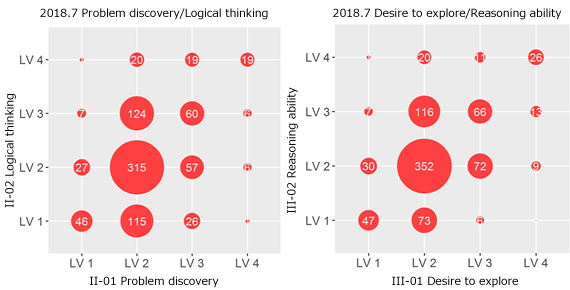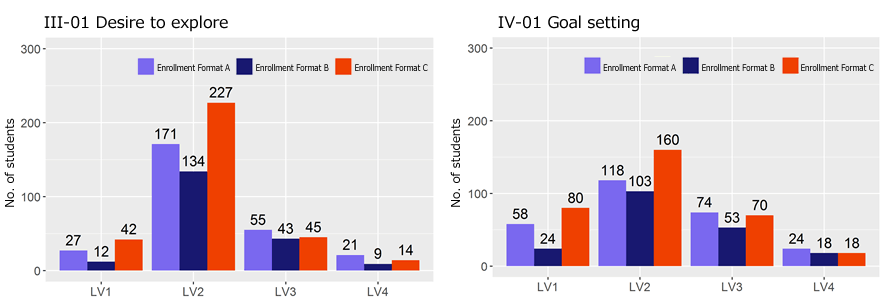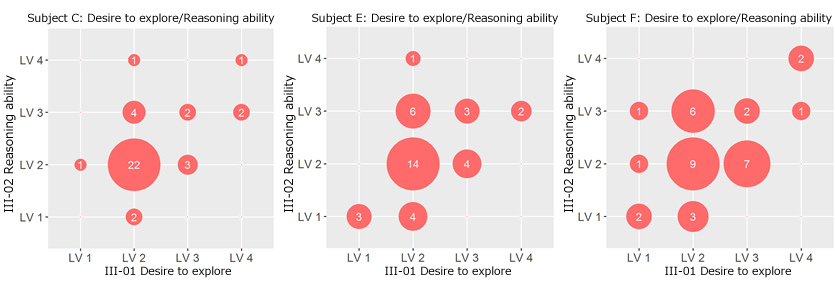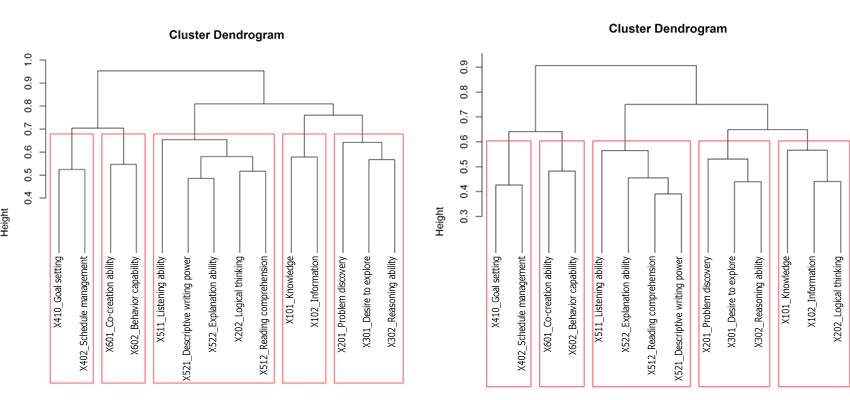Top>Education>How Can We Measure Learning Ability? —Analysis of a Competency Self-Assessment Questionnaire—
How Can We Measure Learning Ability?
—Analysis of a Competency Self-Assessment Questionnaire—
Yu Saito
Teacher, Department of Japanese Linguistics, Chuo University Junior and Senior High School
Yoko Neha
Instructor, Department of Information, Chuo University Junior and Senior High School
Designation as an SSH
After Chuo University Junior and Senior High School (hereinafter, “Chufu”) was designated as a Super Science High School (hereinafter, “SSH”) in the 2018 academic year, we decided to develop a competency based evaluation system. According to the new government course guidelines, competency (attributes and abilities) should be positioned for integrated cultivation from kindergarten to high school. However, how can we evaluate the competency of intangible academic ability? One initiative providing insight on this question is “C-compass,” which was developed by the Faculty of Science and Engineering of Chuo University.
C-compass and Chufu-compass
C-compass of Chuo University makes it possible to measure the achievement level of competency by using a questionnaire with thirty-six keywords in seven categories. For our purpose, we adopted six of the seven categories which were prepared for university students in C-compass (the keyword “Ability to respond to diversity” was excluded). On the other hand, we divided the “Communication ability” item in C-compass into two categories, reduced the number of answering levels from five to four for all questions, and carefully reduced the number of questions in half. The result was Chufu-compass, a questionnaire composed of seven categories (6+1) and 14 keywords.
A detailed explanation for the content of Chufu-compass is listed below.
http://chu-fu.ed.jp/topics/wp-content/uploads/2019/01/6d7424708078f66ef6202548e92abbbb.pdf
The first survey
For the competency survey conducted in July 2018, we cooperated with Tokyo Metropolitan High School of Science and Technology (a former SSH) and Tokyo Metropolitan Tama High School of Science and Technology (a present SSH). In addition, we requested cooperation from our graduates who were enrolled at that time as students in the Faculty of Science and Engineering of Chuo University. As a result, over 2,000 questionnaires were collected.
When analyzing the questionnaire, we referred to a method used in the four-point method of the Likert scale. We treated portions which required numerical summary using representative values as an interval scale, and all other portions as an ordinal scale. Furthermore, in order to explore response trends and shared items between questions with close representative values, we used the distance calculated from Spearman’s rank correlation coefficient and the polychoric correlation coefficient to perform hierarchical cluster analysis using Ward method (Figures 1 and 2). Additionally, we performed cross analysis in order to examine the relationships among multiple questions. Then, we displayed the tabulated results in a balloon plot in order to enable intuitive understanding for the distribution (Figures 3, 4, and 7 to 13).
ICT Version_Sample Questionnaire (Googleforms)
Results and observations
The results of our first competency questionnaire survey clarified the following points.
1) The categorization itself used in Chufu-compass is valid
When we performed cluster analysis, response data trends were clustered in each category. These results demonstrate the credibility of the categorization method.
2) Relationship between category II (01 Problem discovery/02 Logical thinking) and category III (01 Desire to explore/02 Reasoning ability)
When using cross analysis to plot response trends of each category on two axes, we observed a prevalent trend in which responses are concentrated near Level 2 for both categories.

Figures 3 & 4: Category II and III Cross tabulation
3) Relationship between Category V (1) (01 Listening ability/02 Reading comprehension) and Category VI (01 Co-creation ability/VI-02 Behavior capability)
We observed an unexpected proximity in response trends for Category V (1), which involves effort to listen to others and understand them, and Category VI, which seeks to recognize each other’s existence and accomplish tasks through cooperation.
4) The five items of Category I (01 Knowledge), Category IV (01 Goal setting/02 Schedule management), and Category V (2) (01 Descriptive writing power/02 Explanation ability) can be extracted as items which are generally difficult for high school students
Students at three schools with different curriculums and school cultures had difficulty with these same categories.
5) Competencies tend to differ among students with different enrollment formats
Enrollment was grouped into recommendations (A), general entrance examinations (B), and internal enrollment from affiliated junior high schools (C). As the result of comparison of responses in these groups, we observed a relatively low level of competencies among students enrolling from affiliated junior high schools.

Figures 5 & 6: Categories III and IV for enrollment format of first-year and second-year high school students (click to enlarge)
6) Competencies tend to differ among students in each class of the cross-curriculum course Comprehensive Liberal Arts I
When comparing competencies among students in different classes of the cross-curriculum course Comprehensive Liberal Arts I, we observed differences in the trends for each class.

Figures 7 to 9: Categories III and IV by each class of Comprehensive Liberal Arts (click to enlarge)
7) Increase in academic age from third year of high school to university student does not lead to smooth improvement of competencies

Figures 10 to 13: Comparison of four years: 1st year of high school, 2nd year of high school, 3rd year of high school (science), and graduates (Faculty of Science and Engineering) (click to enlarge)
Relationship with the 10-Year Transition Survey
The following two points were summarized as results in the Second Term Results Report of the Transition Project from School to Work (commonly known as the 10-Year Transition Survey; Representative: Shinichi Mizokami).
- Half of second-year high school students become university students without significant changes in attributes or abilities.
- The home study, interpersonal relationships, communication, and career awareness of second-year high school students affect their learning in a variety of ways, including attributes and abilities during the first year of university
The point raised in 1. above is in accordance with the results of analysis in our survey; namely, increase in academic age from third year of high school to university student does not lead to smooth improvement of competencies.
Furthermore, this survey indicates the necessity of forming the habit of home study (the attitude of autonomous learning) based on personal career awareness; i.e., an outlook for the future. This habit must be formed by the second year of high school at the latest (called the “third-year high school gap”). It goes without saying that it is necessary to possess the ability to construct interpersonal relationships and engage in communication with other people possessing a variety of values. This matches the following general competency issues for high school students which were identified during the comparison of three schools in Chufu-compass.
- Possessing an outlook based on awareness of personal involvement (attitude of autonomous learning)
- Producing output based on awareness of other people (interpersonal relationships and communication)
When reflecting on our activities based on the 10-Year Transition Survey, if second-year of high school can serve as a rough guide, the Comprehensive Liberal Arts course offered at our school is positioned at the final stage of competency formation during childhood.
Future aspirations
Our analysis started with the goal of identifying the true structure existing behind data in circumstances without output having been decided in advance, and then using what we identified to contribute to daily education activities. Since this academic year marked our first survey ever, it is nothing more than one instance of data. Moving forward, we will work hard to create a detailed series of data.
Chufu-compass is not intended as a specific and individual evaluation of classes. Instead, it is simply designed to create recognition through indices based on the self-evaluation of students. If an understanding of this point can create a change in the awareness of instructors who are involved directly with students, we believe that students will acquire greater confidence in their abilities and will become able to cultivate themselves via their won ability—right before our very eyes.
Reference literature
- Curriculum Guidelines for High Schools, Ministry of Education, Culture, Sports, Science and Technology, 2018
- Second Term Results Report of the Transition Project from School to Work, Center for the Promotion of Excellence in Higher Education, Kyoto University and Kawaijuku Educational Institution, 2017
- Data science by R, Jin Mingzhe, Morikita Publishing, 2017
- Essence of Connecting High School and University: Issues Clarified by the Transition Project from School to Work (What kinds of high school students grow at university and in society? 2), Shinichi Mizokami, Gakuji Shuppan, 2018
- Yu Saito
Teacher, Department of Japanese Linguistics, Chuo University Junior and Senior High School
-
Yu Saito graduated from the Faculty of Education, Tokyo Gakugei University.
In 2005, he was appointed as teacher at Chuo University Suginami High School.
He assumed his current position in 2018.
Research themes: Japanese language education and competency development. For the research discussed in this article, he devised questionnaire items and decided on analysis policy. - Yoko Neha
Instructor, Department of Information, Chuo University Junior and Senior High School
-
She graduated from the Faculty of Engineering at the Musashi Institute of Technology (currently Tokyo City University).
Research themes: Information Education and Math/Science Education. For the research discussed in this article, she proposed analysis methods and oversaw analysis work.
- Research Activities as a Member of Research Fellowship for Young Scientists (DC1), Japan Society for the Promotion of Science (JSPS) Shuma Tsurumi
- Important Factors for Innovation in Payment Services Nobuhiko Sugiura
- Beyond the Concepts of Fellow Citizens and Foreigners— To Achieve SDGs Goal 10 “Reduce Inequality Within and Among Countries” Rika Lee
- Diary of Struggles in Cambodia Fumie Fukuoka
- How Can We Measure Learning Ability?
—Analysis of a Competency Self-Assessment Questionnaire— Yu Saito / Yoko Neha - The Making of the Movie Kirakira Megane

-
Newest Edition 2019 Autumn Issue
Student journalists report on the students’ take of Chuo University

-
Chuo-DNA
The school's history and motto have been passed on to graduates and students alike. Here is a visualization of Chuo University in the future.Core Energy
Launching Chuo University's Knowledge into Action to the rest of the world, like an infinity of sparkling stars scattered throughout space.
Planned by The Yomiuri Shimbun Business Bureau [PR]

















